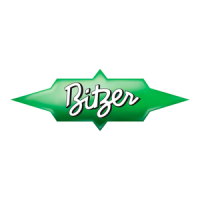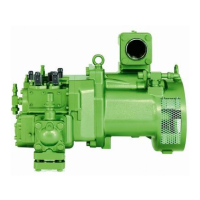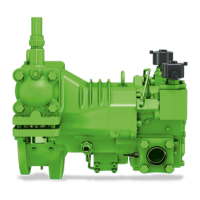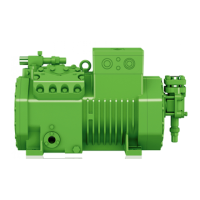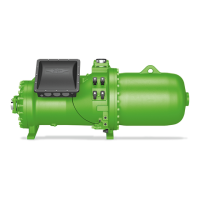15SB-500-2 i
5 In Betrieb nehmen
Der Verdichter ist ab Werk sorgfältig
getrocknet, auf Dichtheit geprüft und
mit Schutzgas (N
2
) befüllt.
Achtung!
Druckfestigkeit und Dichtheit der
gesamten Anlage bevorzugt mit
getrockneten Stickstoff (N
2
) prü-
fen.
Bei Verwendung von getrockne-
ter Luft Verdichter) Ölabscheider
und Ölkühler) nicht einbeziehen
– Absperrventile unbedingt
geschlossen halten.
Gefahr!
Verdichter darf keinesfalls mit
Sauerstoff oder anderen techni-
schen Gasen abgepresst wer-
den!
Warnung!
Dem Prüfmedium (N
2
oder Luft)
keinesfalls Kältemittel beimi-
schen – z. B. als Leck-Indikator.
Kritische Verschiebung der
Kältemittel-Zündgrenze bei
Überdruck möglich!
Umweltbelastung bei Leckage
und beim Abblasen!
5.1 Öl einfüllen
Ölsorte: siehe Abschnitt 2. Hinweise
im Handbuch SH-500 beachten.
Füllmenge: Betriebsfüllung von Ölab-
scheider und Ölkühler (siehe Tech-
nische Daten im Handbuch SH-500)
zuzüglich Volumen der Ölleitungen.
Zusatzmenge für Ölzirkulation im Kälte-
kreislauf ca. 1..2% der Kältemittel-
füllung; bei Systemen mit überfluteten
Verdampfern ggf. höherer Anteil.
Achtung!
Kein Öl direkt in den Verdichter
füllen.
5 Commissioning
The compressor is already thoroughly
dehydrated, tested for leaks and
under pressure with holding charge
(N
2
).
Attention!
Test strength pressure and tight-
ness of the entire plant prefer-
ably with dry nitrogen (N
2
).
Compressor (oil separator and
oil cooler) must not be included
when using dried air – keep the
shut-off valves closed.
Gefahr!
By no means the compressor
may be pressure tested with
oxygen or other industrial gases!
Warning!
Never add refrigerant to the test
gas (N
2
or air) – e. g. as leak
indicator.
Critical shift of the refrigerant
ignition limit with high pressure
possible!
Environmental pollution with
leakage or when deflating!
5.1 Oil filling
Oil type: see section 2. Observe rec-
ommendations in manual SH-500.
Oil charge: Operation charge of oil
separator and oil cooler (see technical
data in manual SH-500) plus volume
of the oil pipes. Due to the oil migration
in the refrigeration circuit, add approx.
1..2% of the total refrigerant charge;
in case of systems with flooded evap-
orators possibly a higher percentage.
Attention!
Do not fill oil directly into the
compressor.
5 Mettere in servizio
In officina il compressore è stato asciuga-
to accuratamente e caricato con gas pro-
tettivo (N2) ed è stata controllata la sua
tenuta.
Attenzione!
Controllare la resistenza alla pres-
sione e la tenuta di tutto l'impianto
preferibilmente con azoto secco
(N2).
Usando aria secca escludere il com-
pressore, il separatore d'olio e il raf-
freddatore dell'olio - è assolutamen-
te necessario tenere chiusi i rubinet-
ti.
Pericolo!
Il compressore non deve essere
pressurizzato con ossigeno o altri
gas tecnici!
Avvertimento!
Mai aggiungere alcun refrigerante
durante la prova (N2 o aria) - ad es.
come indicatore di fughe.
Possible spostamento del limite criti-
co di infiammabilità del refrigerante
in caso di sovrappressione!
Inquinamento ambientale in caso di
fughe e di scaricamento!
5.1 Carica olio
Tipo d'olio: vedi paragrafo 2. Osservare
le avvertenze contenute nel manuale
SH-500.
Volume di riempimento: carica di fun-
zionamento del separatore d'olio e del
raffreddatore dell'olio (vedi i Dati tecnici
nel manuale SH-500) più il volume nelle
tubazioni dell'olio. Quantità addizionale
per la circolazione dell'olio nel circuito fri-
gorigeno circa il 1..2% del volume di
riempimento del refrigerante; in caso di
sistemi con evaporatore allagato quantita
puó essere superiore.
Attenzione!
Mai versare olio direttamente nel
compressore.

